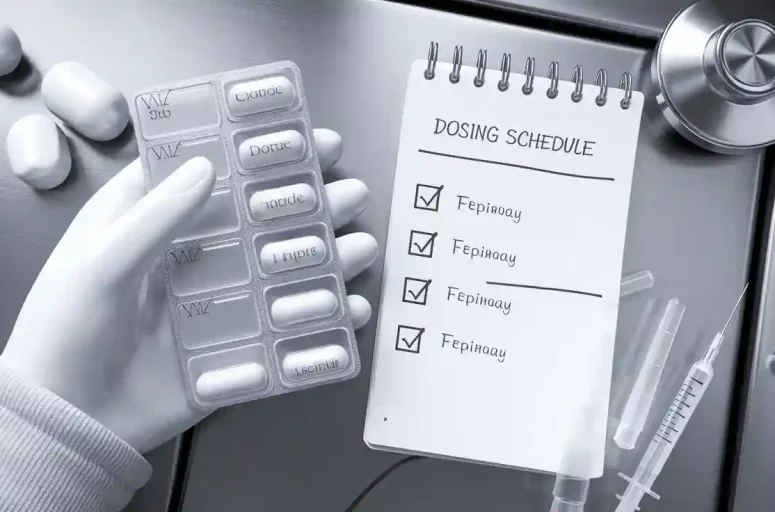
If you use selective androgen receptor modulators (SARMs), you might ask about SARM safety and what long-term effects they could cause. Clinical trials in 2025 provided important answers to these concerns. For instance, enobosarm with semaglutide slowed the drop in physical ability by 62.4% compared to placebo groups. These results highlight the potential benefits of SARMs, but understanding their safety is crucial before using them.
Disclaimer: This article is only for information and not medical advice. Always talk to a doctor before using SARMs.
Key Takeaways
SARMs are chemicals that help grow muscles and make bones stronger with fewer dangers than steroids.
Tests in 2025 showed SARMs can slow physical decline, but safety worries still exist.
Short-term problems from SARMs include liver harm, muscle loss, and hormone changes.
Using SARMs for a long time may cause jaundice, high blood pressure, and trouble having kids.
Taking small amounts of SARMs for a short time can lower side effect risks.
SARMs are not allowed by the FDA and are banned in pro sports, showing they are in a legal gray area.
Natural supplements are safer options than SARMs, giving benefits with less risk.
Always talk to a doctor before using SARMs to stay safe and make smart choices.
Understanding SARMs
What are SARMs?
Selective androgen receptor modulators (SARMs) are chemicals that act like steroids but with fewer risks. Unlike steroids, SARMs focus on certain parts of the body, like muscles and bones, while avoiding areas like the prostate. This makes them useful for building muscle and strengthening bones without major hormone problems.
SARMs were first made in the 1940s by changing the testosterone molecule. Scientists later created different types, including steroidal and nonsteroidal versions. Today, SARMs are being tested to help treat diseases like weak bones, muscle loss, and low testosterone. The best SARMs are easy to take, work with one daily dose, and have few side effects.
How SARMs work
SARMs attach to special receptors in your body called androgen receptors. These receptors control how muscles and bones grow. When SARMs connect to these receptors, they start processes that help tissues grow stronger. They mainly work on muscles and bones but have less effect on other areas, like the prostate.
Here’s a table showing how SARMs work:
Feature | Explanation |
|---|---|
Tissue Focus | SARMs help muscles and bones grow while avoiding the prostate. |
Helper Proteins | SARMs use proteins to boost or limit their effects based on the tissue. |
Quick Effects | SARMs also work fast through special receptors on cell surfaces. |
This targeted action lets SARMs give muscle and bone benefits without the serious problems linked to steroids.
Common uses of SARMs
SARMs are used for both medical and fitness reasons. Doctors study SARMs to treat muscle loss from illnesses like cancer or weak bones from osteoporosis. By helping muscles and bones grow, SARMs may improve life for sick patients.
In sports and bodybuilding, SARMs are popular for boosting performance. People use them to gain muscle, lose fat, and get stronger. SARMs are thought to be safer than steroids, which makes them appealing to athletes and gym-goers.
But SARMs can still be risky. Taking too much or using them for too long can harm your health. Always talk to a doctor before using SARMs for any reason.
SARM safety based on 2025 clinical trials
Key findings on short-term safety
The 2025 trials gave new details about SARM safety. SARMs are often seen as safer than steroids, but they still have risks. Studies showed some short-term side effects you should know about:
Muscle breakdown, called rhabdomyolysis, may hurt your kidneys.
Tendons can tear due to extra strain on tissues.
Hormone changes like lower testosterone and less good cholesterol (HDL).
SARMs aim to work on certain body parts, but side effects can still occur. Some users said they had headaches, dry mouth, or felt sick. These problems show why it’s important to watch your health if using SARMs.
The trials also found enobosarm with semaglutide helped older adults keep muscle without causing stomach issues. This shows SARMs might help in the short term if used carefully. But full safety results won’t be ready until April 2025. Until then, use SARMs carefully and talk to a doctor first.
Long-term side effects of SARMs
Knowing long-term effects is key to understanding SARM safety. Studies found several possible long-term problems from using SARMs:
Side Effect | Description |
|---|---|
Yellow skin from liver problems. | |
High blood pressure | Blood pressure levels go up. |
Low testosterone | Testosterone levels drop. |
Smaller testicles | Testicles shrink in size. |
Acne | Pimples appear on the skin. |
More red blood cells | Blood thickens due to higher red cell levels. |
Headaches | Pain in the head area. |
Dry mouth | Mouth feels dry and uncomfortable. |
Respiratory infections | Illnesses in the nose or throat. |
Constipation | Trouble passing stool. |
Indigestion | Stomach feels upset or uncomfortable. |
Nausea | Feeling sick or wanting to vomit. |
These effects show the risks of using SARMs for a long time. Liver damage, like jaundice, is a big concern. Hormone problems, such as low testosterone and smaller testicles, can also harm your health.
The trials haven’t finished studying long-term safety yet. Early data from over 1,500 people didn’t show major safety issues. This suggests SARMs might be safe if used properly. Still, regular health checks are important if you use SARMs for a long time.
Impact of dosage and duration on safety
How much and how long you use SARMs affects their safety. Higher doses and longer use make side effects more likely. Problems like liver damage and hormone changes get worse with misuse. Side effects like acne, headaches, and nausea also increase with high doses.
Studies show SARMs work well at low doses for medical use. For example, enobosarm helped keep muscle without big side effects when used carefully. But fitness users often take higher doses than tested, which raises risks and lowers safety.
If you want to try SARMs, start with the smallest dose and use them for a short time. Always ask a doctor to make sure your use is safe and follows medical advice.
SARMs side effects compared to other substances
SARMs vs. anabolic steroids
SARMs and anabolic steroids have different side effects. SARMs are often called safer, but they still have dangers. Both can harm the liver, causing drug-related liver problems. The FDA warns that SARMs, like steroids, may cause serious health issues.
Here are some side effects of SARMs:
Higher chance of heart attack or stroke
Mental health issues like psychosis or seeing things
Trouble sleeping
Problems with sexual health
Trouble having children
Pregnancy loss
Smaller testicles
Steroids share some of these risks but affect the body more widely. Steroids can cause hormone problems, mood swings, and lasting changes like deeper voices or hair loss. SARMs target specific areas but are not completely safe. Experts say SARMs need more study, and their long-term effects are unclear.
SARMs vs. natural supplements
Natural supplements, like protein powder or creatine, are very different from SARMs. Supplements come from natural sources and help your body’s normal functions. SARMs are man-made chemicals that act like steroids. This is why SARMs are riskier.
Supplements rarely cause big problems if used properly. For example, creatine might cause mild dehydration or stomach upset if overused. SARMs, however, can harm the liver, mess up hormones, and hurt the heart. Supplements work slowly to improve performance, while SARMs work faster but with more risks. If you want to stay safe, natural supplements are a better option.
Safety and efficacy differences
How safe and effective SARMs are depends on how you use them. SARMs help build muscle and strengthen bones, but they can be dangerous. High doses or long-term use may cause liver failure and hormone problems. Natural supplements are less powerful but safer for long-term use.
Steroids are very strong but come with high risks of lasting harm. SARMs are in the middle, offering focused benefits with fewer side effects than steroids but more risks than supplements. The FDA warns about SARMs and says more research is needed to understand their safety.
If you’re thinking about using SARMs, consider the risks and benefits. Always talk to a doctor to make a smart choice.
Risks and benefits of SARMs

Potential benefits of SARMs
SARMs may help people improve their physical health. They can increase muscle size and make bones stronger. Unlike steroids, SARMs focus only on muscles and bones. They don’t affect other parts of the body, like the prostate. This makes them popular for people wanting safer performance boosters.
Doctors are studying SARMs to treat health problems. They may help with muscle loss from cancer or weak bones from osteoporosis. For example, enobosarm might help older adults keep muscle strength. This could make moving easier and improve their lives. SARMs might also help heal injuries by fixing damaged tissues.
Athletes and gym-goers use SARMs to build muscle, lose fat, and get stronger. SARMs work faster than natural supplements like protein powder or creatine. This makes them a favorite for quick results. But while these benefits sound great, it’s important to think about the risks.
Common risks and adverse effects
Using SARMs can be dangerous, especially if you don’t use them correctly. One big problem is liver damage. Studies found that SARMs can raise liver enzymes, which may harm the liver. This shows that SARMs can hurt your body if misused.
SARMs can also mess up your hormones. They might lower testosterone levels, causing tiredness and less interest in sex. Long-term use can make it hard for your body to make testosterone naturally. Other problems include high blood pressure, acne, and heart issues. Some people also feel sick, get headaches, or have dry mouths.
SARMs can affect your mood too. They might cause anxiety or mood swings. These problems are worse with high doses or long use. If you’re thinking about SARMs, you should carefully consider these risks and talk to a doctor first.
Weighing risks against benefits
Before using SARMs, think about the good and bad sides. SARMs can help you grow muscle and strengthen bones faster than natural supplements. They might also help people with certain health problems. But the risks, like liver damage and hormone issues, are serious.
SARMs seem safer than steroids but riskier than natural supplements. To stay safe, use the smallest dose and don’t take them for too long. Always check your health while using them.
Your choice to use SARMs should depend on your goals and how much risk you’re willing to take. Focus on staying healthy instead of chasing quick results. Talking to a doctor can help you make a smart decision and avoid serious problems.
Legal and ethical considerations of SARMs
Current legal status
SARMs are in a legal gray area. In the U.S., the FDA has not approved SARMs for regular use. They are investigational drugs, meaning their safety is still being studied. Despite this, SARMs are sold online as supplements or research chemicals. This avoids strict rules and confuses buyers.
The World Anti-Doping Agency (WADA) bans SARMs in professional sports. Athletes using SARMs can face penalties or disqualification. Many countries also restrict SARMs for sports use. However, enforcement differs, and some areas lack clear rules. Always check your local laws before buying or using SARMs.
Ethical concerns in sports and fitness
Using SARMs raises moral questions, especially in sports. Athletes often hide drug use from doctors due to fear or mistrust. This secrecy can lead to untreated side effects and health risks.
Here are some ethical issues with SARMs:
SARMs are unapproved, and their long-term effects are unknown.
Using SARMs in sports is unfair to others.
Risks like liver damage and depression are not well-studied.
Using SARMs may create moral conflicts. Enhanced performance can give an unfair edge. It may also pressure younger athletes to use them. Ethical fitness focuses on fairness and health, not shortcuts.
Regulatory challenges and future outlook
Regulating SARMs is hard. Their investigational status limits control, letting sellers use tricky labels. Online sales make it tough to enforce rules. This increases the chance of fake or unsafe products reaching buyers.
Governments are trying to fix these problems. Better labels and stricter penalties could help protect consumers. But SARMs’ investigational status makes regulation tricky. Until trials confirm their safety, balancing risks and benefits is tough.
The future of SARMs depends on research. If proven safe, they might become approved treatments for muscle loss. This could lead to stricter rules and clearer guidelines. For now, be cautious and stay updated on legal and ethical changes.
SARMs can help muscles grow and make bones stronger. But they also have big risks. Using SARMs for a long time might hurt your liver. They can mess up hormones and even cause fertility problems. Dr. Justin Dubin says SARMs might make you dependent on them. They could also lead to serious issues like infertility or kidney damage. These risks are worse for young men who want kids someday.
Think about the good and bad sides before using SARMs. They may seem safer than steroids, but they still have dangers. If you’re thinking about trying SARMs, focus on staying healthy. Always talk to a doctor first. For most people, the risks are not worth it.
FAQ
What are SARMs used for?
SARMs help grow muscles and make bones stronger. Doctors study them to treat weak muscles and bones. Fitness fans use them to gain muscle, lose fat, and perform better.
Are SARMs safer than steroids?
SARMs focus on certain body parts, causing fewer side effects than steroids. But they still have risks like liver harm and hormone problems. Always ask a doctor before using them.
Can SARMs cause liver damage?
Yes, SARMs can hurt your liver, especially with high doses or long use. High liver enzyme levels are a warning sign. Regular health checks are very important.
Are SARMs legal to use?
SARMs are not approved by the FDA for regular use. They are experimental drugs and banned in pro sports. Check your local rules before buying or using them.
Do SARMs affect testosterone levels?
SARMs can lower testosterone, making you tired and less interested in sex. Long-term use might stop your body from making testosterone naturally.
How do SARMs compare to natural supplements?
SARMs work faster but are riskier. Natural supplements like protein powder and creatine are safer for long-term use. SARMs can harm your liver and hormones.
Can SARMs cause fertility problems?
Yes, SARMs can lower testosterone and shrink testicles, which may cause infertility. Young men should think carefully about these risks before using SARMs.
Should you use SARMs for fitness?
Think about the risks and benefits. SARMs give quick results but can harm your health. Safer options like natural supplements might be better for long-term fitness goals.


